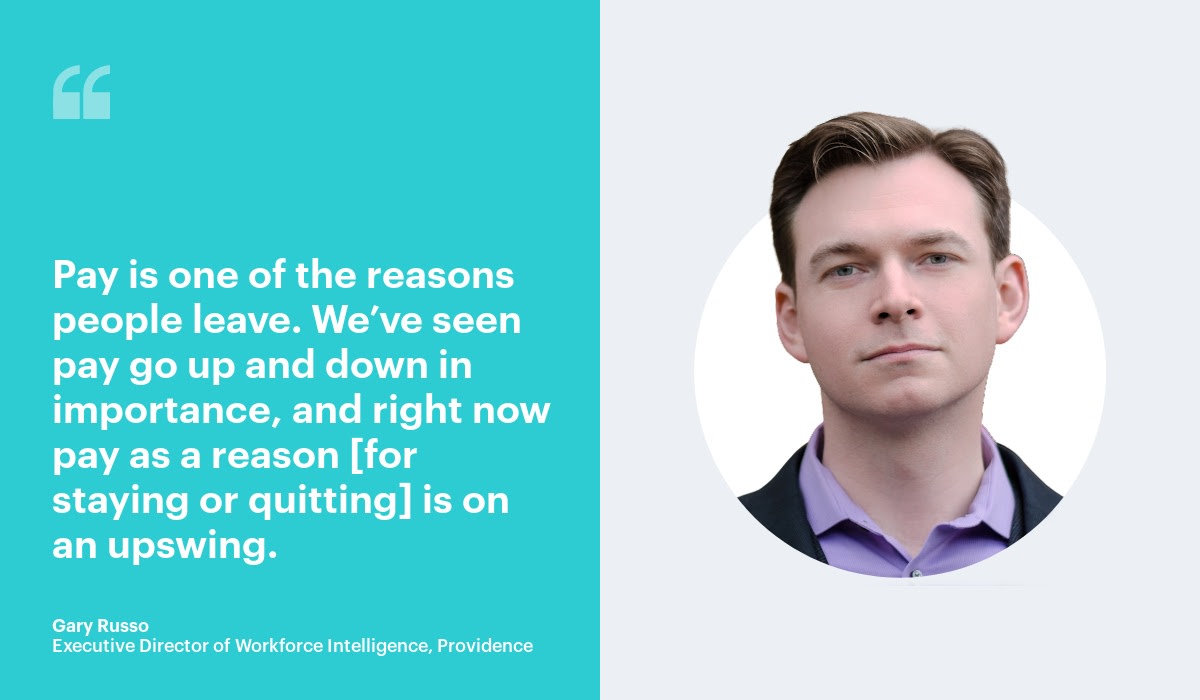4 Ways People Analytics Improves Health Care Workers’ Experience
Outsmart 2022 brought together experts to discuss trends and innovations in people analytics. Read the top takeaways from the two-day event.

Whether it’s backfilling roles vacated by burned out caregivers or renegotiating compensation in a time of wage inflation, health care worker retention will continue to be an issue in the healthcare industry. Unfortunately, the squeeze from rising wages and labor costs can’t be passed on to patients. So that means using innovation and clever HR strategies to find a way to make the numbers work.
Below are four ways healthcare organizations leveraged their people data to uncover creative solutions to their staffing concerns without having to increase budgets. In many cases, these strategies actually saved millions of dollars—all of which can be funneled directly towards patient care:
Focusing on the right workforce groups saves recruiting costs for health care workers
Providing PTO bonus curbs employee turnover during a crisis
Leveraging natural attrition for health care workers instead of terminations
Proving increasing pay leads to employee retention
1. Focusing on the right workforce groups saves recruiting costs for health care workers
Mark Smith, Vice President of Workforce Strategy and Analytics for Providence, a comprehensive healthcare system serving the Western United States, knows how accurate data analysis can help with issues such as a nursing shortage.
In a recent webinar, Mark shared that hiring requests for their per diem workforce had been increasing to the point where almost 13% of their requisitions were for this cohort. “That might not be too bad until you also look at it and realize that our time-to-fill overall was somewhere around 45 days in aggregate, but time-to-fill for a per diem position was almost 120 days,” he says.
They then looked at variable shift position data. Variable shifts (also called rotating shifts) mean that instead of working a traditional eight-hour day, or a four-hour day for part-time health care workers, employees work longer hours in a day, but fewer days per week. For Providence, it turned out that filling variable shifts also took a long time—90 days, in fact.
Digging deeper into their per diem and variable workforces, they also found that both groups were leaving in less than 90 days after hire at almost a 60% rate. These quadrants were also ghosting their talent acquisition team over 25% of the time.
All these data points enabled Mark’s team to go to the hiring managers and advise them to focus on the 0.5 to 0.74 caregivers—people who work half or three-quarter shifts—because talent acquisition teams could hire them fast, and the first year turnover metrics were better for that cohort.
For the full story, watch Mark’s clip below:

2. Providing PTO bonus curbs employee turnover during a crisis
Increased retention rate to 94.68%
Realized an ROI of 158%
Reduced annualized turnover rate to 10% for at-risk cohort
During the COVID-19 pandemic, Baptist Health, a mission-driven not-for-profit healthcare organization, saw higher employee turnover among their health care workers and couldn’t recruit fast enough to permanently fill the vacant roles. Steve Rudolf, System Vice President, Human Resources at Baptist Health, looked carefully at his organization’s turnover metrics and noticed that Baptist Health’s turnover aligned very closely with COVID-19 surges.

Monitoring turnover in real time was the first step in solving the problem
“Based on what we were forecasting, we knew the Omicron surge was going to hit in December and January. And, if we continued to turn over staff at our current level, we would not be able to provide the care that we needed for our patients. So, we needed to figure out a way to retain our staff,” he explains.

Everyone was feeling the crunch as health care workers were not able to take time off as they normally would. Frontline workers were struggling with the mental and emotional toll of seeing so many patients come through the doors and this exhaustion was causing many to feel burnout.
Baptist Health decided to offer additional PTO as a retention reward for staff who remained with the organization. The analytic capabilities Visier gave the Baptist Health team helped them gauge the success of the project in multiple ways:
They could monitor the first retention curve in real time and sound the alarm to move quickly
The estimated cost of turnover became easier to determine, which then gave them an estimated return on the investment being made in additional PTO. Average turnover costs Baptist Health millions every month—this program cut that loss in half, with proven savings and a positive return on investment due to reduced turnover. More importantly, this slowdown in attrition gave Baptist Health’s talent acquisition team a much-needed chance to catch up.
Baptist Health has also raised salaries and is taking a data-driven, targeted approach to other employee retention efforts: “One of the things that we were able to use Visier for is when we saw that steep [turnover] curve, we wanted to find out if that curve was systemic, or was it related to certain parts of our organization? And, we were able to quickly dissect the data to say it does affect this area, but it doesn’t affect this other area. We knew that we had high turnover in our acute care hospitals. We thought we had high turnover in our home care organization, but when we peeled the onion back, that did not necessarily prove out.”
Because they were able to dissect the data to make sure that they were careful in where they spent, they could apply the program to where it was needed most to address turnover in the exact areas that needed help.
For the full story, read Baptist Health’s case study here.
3. Leveraging natural attrition for health care workers instead of terminations
$400,000 in savings
Reduced headcount without terminations, which improved morale
Met union guidelines while retaining newer staff
In order to meet its financial goals, a healthcare organization with over 50,000 employees needed to reduce nurse headcount in a hospital with a declining patient count. This organization also has a union agreement requiring that the last hired was the first out, which meant new nurses would be the focus of any reductions.
The analysis was multi-pronged. The analytics team looked at the costs to acquire and retain new nurses in the affected location, as well as retirements compared to their other locations. They found it was more expensive to hire and harder to keep the new nurses hired in the affected location. This location also had four times more people eligible to retire than the organization’s other hospitals.
Armed with this data, HR proposed that, instead of letting go of the new nurses they had spent so much to find–and might need to hire back later when planned retirements would lead to losses–they advocated for promoting early retirements to see how much of the target reduction in force could be achieved.
Results? The direct costs of laying off the new nurses would have been $1.5 million, but letting natural attrition take place instead led to $400,000 as a direct cash saving—and not a single new nurse was let go.
For the full story, read this healthcare organization’s case study here.
4. Proving increasing pay leads to employee retention
$6 million saved annually by upping pay
30% improved retention in key areas
Extremely targeted: < 1% of jobs analyzed were sensitive to pay
Another great staffing solution from Providence involved testing whether raising pay could actually save the organization money. Gary Russo, the executive director of Workforce explained that this counterintuitive idea hinges on the costs of attrition.
Most people would anecdotally agree that higher pay reduces attrition, but even without budgetary concerns, there is a point of diminishing returns where increasing pay simply stops being a good lever for retention. With people analytics, his team located the sweet spot where raising pay yields a positive return on investment.
By using historical data to predict the future, they assessed data on the relation between salary range and the associated turnover range. The compa-ratio let them bucket people into groups paid either above the midpoint or below the midpoint. Instead of worrying about the exact dollar amount, it was more about if they were paid in relation to the job they were in, and the pay grade midpoint was a useful proxy for a market competitive wage.
Once they had these pay buckets, they took the experimental group for a given time bracket, lined them up by date of hire, and saw how many stuck around over time. Since they already knew who had left and who had stayed, what their pay had been with regards to the midpoint, and had the data to control for other variables, they could visually demonstrate to the leadership the real cost of paying people below the midpoint range for their role.
Using the estimated costs of turnover and calculating the cost to adjust salaries in the targeted groups, Gary estimated Providence could save $6 million dollars a year. For a non-profit that operates on a thin margin, this means millions of dollars going directly towards better patient care.

For the full story, read Providence’s case study here.
Data is key to better healthcare workforce strategies
Every time a company hires a new employee, it’s because they recognize that employees bring value to the organization. In many cases, the value of the work that a health care worker provides is two or three times the wages they receive. For some roles, such as the case of a highly skilled specialty nurse, the value of work can balloon past 800% of their salary. No organization can operate without its people, and good leaders need to know what motivates health care worker to stay, leave, or accept a position.
“We’re always looking for levers. Among ten great ideas, ‘is pay a driver of retention’ is one of them,” Gary said. When budgets aren’t endless and patient care is on the line, HR and other leaders need an edge, and having access to people insights provides that advantage.
Get Outsmart content straight to your inbox
Subscribe to the People Insights Monthly newsletter for actionable insights and stories.
Subscribe now